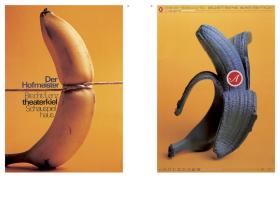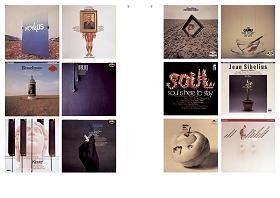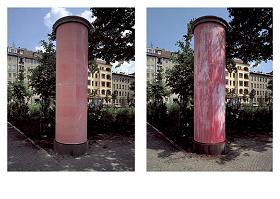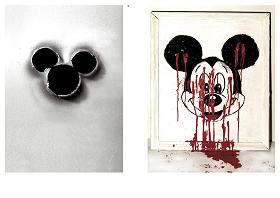|
Interview with Prof. Holger Matthies
1. You are a professor of graphic design, yet to me you are primarily a successful designer. Do you think these are two completely different careers? Which one means more to you? How do you compromise the teaching of graphic design and your own practice of it?
Of course, the flow of information and conveying through teaching feed
on the experiences of one’s own professional life. The practical and
theoretical knowledge cannot be transferred to the education at a 1:1
ratio. Knowledge and realizations from the practical field, however,
often serve as stimulators and marker for the formulation of the
problem and the corrective discussion, especially because students will
encounter the same professional routine and everyday life with similar
structures and problems when leaving university.
2. During your educational communication with the students, has your work ever been influenced by the younger minds of design? If yes, in which respect is this so? How do you look at such an influence?
As in good and less good vintage years, there are quality fluctuations
within the cycle of student years. If the grapes are sweet everybody
participates, even the professor.
3. As an internationally renowned graphic designer, many of your works are regarded as classics. I’m curious about whether the strong individual style in your characteristic works has an influence on the artistic creations of your students. How do you take hold of this influence? If a student emerges with a style very similar to yours, how would you feel and what would you do?
If during the course of education, a major stylistic dependence or
congruence in the way of working is developed, one has to pull the
emergency brake.
I really hope that the contributions of students in this book give an
impression of their great stylistic spectrum. Training students to be
multipliers of one’s own handwriting would be fatal. I do not reject,
however, relationships of thought.
4. With the rapid development of science and technology, it is inevitable that the application of new technologies enter the realm of design. How do you see the relationship between new-tech and the training of traditional basic skills in your teaching?
The result of the traditional techniques which are learned is basic
knowledge. In essential means, these should absolutely belong to the
educational canon. The new techniques and media are indispensable
although in the work of many students they often seem to be anonymous
and exchangeable in their application.
5. The idea of Globalization is very popular these days. Is graphic design gradually losing its native character and regional identity? May I know your attitude towards the concept of “nationality” in your design and teaching?
The money accumulation of the big joint-stock companies in the time of
globalization is so unbelievably huge that the relapse into the class
society must not be. Bill Gates is buying the visual memory of all
mankind exploiting the ideas and the creativity of whole centuries to
his own advantage. When the striving for profit and speed are the only
motors of globalization, the entire balance gets out of control. In the
future, national identity and regional characteristics will be
sacrificed to fast data transmission and simplified ways of
communication.
6. Speaking of Globalization, I always feel that people today are emphasizing speed more than creativity of design.
How do you understand “speed”?
The post-modern speeding frenzy constantly puts us on the spot and
should be "slowed down".
The idea is the locomotive of our work. It has got all the time it
needs to grow and prosper.
7. Savignac used to say posters are children on the streets. In Europe, people tend to understand the poster as an art on the street. Then, what do you think of posters being exhibited and kept in museums? How much time and effort will you devote to poster design in your class schedule?
The "homo ludens" has a pronounced instinct to live out. In this view all people remain children throughout their lives.
With his statement "Posters are the children of the street" Savignac
wanted to point out their proletarian character. They were not to be
met in elitist but in public spaces, open and comprehensive to
everybody.
That was long ago! Today, posters are collected, have conquered the
museums and are taken for "poster art" in their form. Naturally, they
also are an integral part of the education table of visual
communications and the poster designer’s "lust object".
8. Do you have any specific requirement for design theories in class? What are the books that you usually recommend to your students?
I invite designers who embrace a different school, or who have
developed a contrary handwriting in their work to give lectures or
visiting scholarships. Their publications and books are presented and
discussed.
This way the university closes gaps and blind spots and students gain
access to a wider spectrum of the "universe of design".
9. How would you feel about the achievements and success of your students?
During the diploma exams I am as nervous as my students are. When they
master all the questions, when their practical work is acclaimed, and
when they have passed the diploma exams, I share their happiness.
When their later work is successful or when they are honoured in
competitions, I have reason enough to celebrate with them and to
confirm them in the way they have taken.
Some of my former students are themselves professors or lecturers today.
10. One last question, how do you define a "good designer" and a "good student" respectively? Thank you!
Objective professional images can be found in vocational schools or at
the job centre. The practical field has a different reality in store.
There are only few niches in our profession where critique or
controversies are appreciated.
The person who escapes the spiritual sluggishness of a lethargic
society, who is not afraid of the violation of rules, who agitates and
provokes without insulting the audience, has proven power, persistence
and courage. I respect that!
Jianping He / April 2004
| 








